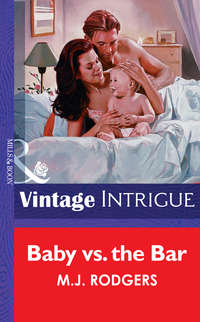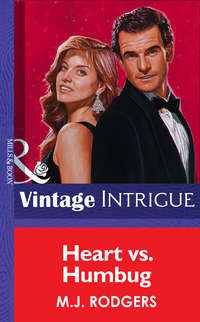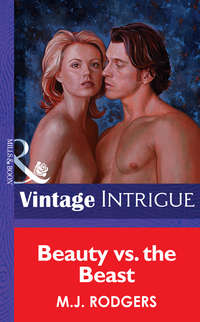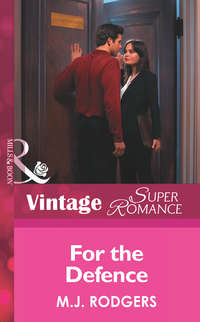
Полная версия
Father By Choice
On a slightly raised platform sat the city council along with Phoebe Landru and Oliver Smithson, Dorothy’s fellow members of the managing board of the Historical Society. The local KSEA TV news crew had set up cameras. Ken Kerr, the society’s photographer, was busy taking pictures with his thirty-five millimeter.
“All we need now is the mayor,” Dorothy said glancing at her watch.
As though hearing his cue, the newly elected mayor, Patrick O’Shea, turned the corner. The TV crew immediately aimed their cameras at him and started to roll. Emily went over to greet him.
The mayor shook her hand warmly, wearing a genuine smile. In Emily’s experience, there were two types of people who went into politics—egoists and idealists. The preponderance of officeholders fit into the first category. Patrick O’Shea, thankfully, fit into the second.
He’d been fire chief before running for mayor, not the kind of job that most candidates for public office held. But maybe the kind that they should. O’Shea knew how to put the welfare of the people of Courage Bay first.
Emily accompanied him to the platform and showed him to his seat. Dorothy had taken her place next to the other members of the Historical Society. The clock in the Botanical Gardens’ Heritage Museum was striking the hour. Everything was in place and on time.
As Emily turned to the crowd before her, she felt proud to be a part of this historical moment for Courage Bay. Raising her hands for quiet, she caught sight of her brother at the right of the large crowd and smiled. When she saw who was standing beside him, the smile froze on her lips.
Oh, no. What in the hell was he doing here?
Emily forced herself to turn her eyes and thoughts away. She was going to let nothing and no one interfere with this momentous occasion. “Ladies and gentlemen, it is my great pleasure to welcome you to our Founders Day Celebration. And it is my deep honor to present to you the mayor of Courage Bay, Patrick O’Shea.”
Emily took her seat beside Dorothy as Mayor O’Shea approached the podium accompanied by enthusiastic applause. When it had died down, he turned to Emily and publicly thanked her for all her hard work in making the celebration a success.
Dorothy rose and began to clap. The crowd quickly joined her as the mayor, city council and other members of the Historical Society’s managing board also got to their feet and applauded. All this focused and very unexpected attention made Emily glad she wasn’t a blusher.
Once the audience had sat down again, the mayor faced forward.
“I want to tell you a story my father told me when I was no more than five,” he began. “It’s a story I’ve passed down to my children. It’s one I hope you will pass down to yours.”
The crowd listened with hushed attention.
“In January of 1848, an American ship called Ranger was caught in a terrible storm at sea and blown off course to these Southern California shores,” O’Shea said. “When the ship was struck by lightning and began to sink, its exhausted crew would certainly have drowned if not for the brave Indians of this land who risked their lives fighting the raging current to bring them safely to shore. In honor of the selfless act of their rescuers, the survivors of Ranger named this settlement Courage Bay.”
Emily knew this story well. Still, she never tired of hearing it told. These events were a proud heritage that she and all the residents of Courage Bay shared. She found herself caught up in the favorite tale.
“When the Indian chief invited the shipwrecked crew to stay, they readily agreed,” the mayor continued. “Protected by this steep mountain range rising on three sides, our quiet community of Courage Bay remained virtually isolated from the outside world until the late nineteenth century when a road was cut through from the north. Even so, it wasn’t until 1904 when the citizens filed their town map with the county recorder’s office that Courage Bay was officially founded.”
Mayor O’Shea paused as he turned toward the large stone sundial to the right of the platform.
“As a marker of that historic event, the leaders of Courage Bay buried a time capsule beneath this enormous sundial they set in the heart of their community park, a park which has grown over the years to become our beautiful Botanical Gardens.”
He faced the crowd. “Today, exactly one hundred years later, we will remove the cover and open that time capsule. I don’t know about you, but I can’t wait to see what our city’s founders have preserved for us.”
Emily nodded to the man sitting in the seat of the crane. He turned on the engine and swung the telescoping crane arm over the sundial.
Earlier that morning she’d supervised the operator and his rigger as they’d dug around the eight-foot-diameter stone they would have to lift. After inserting wedges in several spots, they’d slid a metal plate beneath the sundial to protect it from cracking when it was raised. Slipping three sets of straps beneath the plate, they’d tied them together above the stone.
Lifting it now was a simple task. The rigger on the ground grabbed the steel hook at the end of the crane’s telescoping arm and fixed it beneath the sturdy straps. He then signaled the crane operator to hoist the stone away.
As Emily watched the progress, she’d found herself wondering what it was the founders of Courage Bay had bequeathed them. The sundial had been chiseled when the time capsule had been buried beneath it, specifying when it was to be opened. On the Roman numerals marking the twenty-four-hour segments were the initials of the men who had been selected to set the stone in place.
But nothing on the sundial gave a hint as to what was to be found in the chamber below. If she were to bury a time capsule today, what would she put inside?
Emily’s musings came to a quick close as the stone sundial was lifted and set aside on the cushioned platform prepared for it. The TV camera crew changed position to get a better angle, shining bright lights into the dark chamber below. The big moment had arrived.
Mayor O’Shea and the city council members were the first to reach the sides of the exposed pit and look within. Emily waited in anticipation on the adjacent platform with the other members of the Historical Society.
For a long moment, no one moved or said anything. And then one of the city council members muttered an oath. Another one straightened and stepped back.
Mayor O’Shea calmly turned to face the camera lens. “Ladies and gentlemen, there seems to be a skeleton in our time capsule’s closet.”
CHIEF OF POLICE MAX ZIRINSKY stood over the pit, instructing the Historical Society’s photographer on what angles he wanted him to shoot to get the best pictures of the skeleton that was lying beside the time capsule.
Ed beckoned Brad through the milling crowd—being held back by a line of plainclothes officers—to stand beside them. After introducing Brad to the police chief, Ed got to the reason he’d summoned his friend.
“We need your expertise. If we’re at the scene of a murder, no time capsule gets opened today. All of these very important people are going to be asked to leave so a crime team can get in here.”
“You want me to take a look at this skeleton and hopefully tell you that death was by natural causes,” Brad guessed.
“Can you?”
“I’m not a forensic anthropologist.”
“But you studied to be one,” Ed persisted.
“Even so, I have to warn you the kind of evaluation you’re asking for might not be possible. And even if it is, getting an answer could take a lot of time.”
“If we had a lot of time, we’d get a real forensic anthropologist,” Max said bluntly.
“How much time do you have?”
“Fifteen minutes, tops,” Max answered. “These are not people who are used to being kept waiting.”
No, Brad supposed they weren’t. Nothing he could do but his best. “I’m going to have to get down in the pit to get a closer look. If this is a crime scene—”
“Don’t worry,” Ed said, interrupting. “We’ll take your clothes and process them along with any dirt or whatever else you may pick up if this turns out to be a murder. Here, take these gloves and put them on. I’ll hold your sport coat.”
Brad nodded as he slipped out of his jacket and snapped on the thin evidence gloves Ed had handed him. There was only a three-foot drop to the top of the time capsule. Brad carefully slid down on the side opposite both it and the skeleton.
Bright lights followed his progress, as did a TV camera. Since Max was directing the camera, Brad assumed he’d commandeered the crew for the purposes of chronicling the scene and Brad’s initial examination of it.
His first glance at the fully articulated skeleton from above had already told him something. Decomposition followed a predictable course. The body had to have been placed here soon after death to leave an anatomically correct and intact skeleton like this.
It was also obvious that the bones had been thoroughly cleaned by insects over time and a couple stained a yellowish brown—most likely by some mineral leached from the soil on which they lay.
Brad went down on a knee and bent his head to get a ventral view of the pelvis, noting the relative narrowness of its opening and that of the sciatic notch on the edge of each hip bone. That gave him a pretty good idea about the skeleton’s sex. A cursory look at the leg and arm bones revealed a coarsening, no doubt the result of temperature changes occurring over an extensive period of time.
Then a shift in the overhead light picked up a glint of something near the right pelvic bone. He gently dipped his fingers into the earth, and, to his surprise, pulled out a gold coin.
It proved to be a twenty-dollar Liberty piece bearing the date of 1900. After rooting around in the dirt some more, he came up with something even more unexpected—a mud-encrusted dagger.
Brad’s eyes traveled up the skeleton’s rib cage and vertebral column. The bright light from above revealed no obvious knife marks on the bones. When he got to the skull, there were none there, either. But there was a round hole over one of the brow ridges. He was leaning forward to study it when he saw a dark lump inside the skull. He reached in and pulled out a spent bullet.
As Brad stood, he found Ed bending toward him, holding out an evidence bag. After slipping the dagger, coin and slug inside it, Brad climbed out of the pit.
“I take it we have a homicide,” Ed said as he stared at the dagger, his expression as ill-humored as a man suffering from a toothache.
Brad nodded as he dusted off the knees of his slacks. “Judging by the angle of the entry wound, I doubt that the guy shot himself.”
“Shot? He’s got a bullet wound?”
“My degree isn’t on the forensic side. But I’ve treated enough live shooting victims to recognize one when I see it.”
Brad paused to point at the evidence bag. “Plus which I found that slug inside his skull. The hole in the bone didn’t show any signs of healing, which also leads me to the logical conclusion that the wound was inflicted at the time of death.”
“Bullet must have lodged in his brain,” Max Zirinsky said as he came to stand next to them, looking about as thrilled as Ed did at the discoveries. “Didn’t have sufficient velocity to exit the skull. I’ve seen this kind of thing before.”
Brad noticed that the Chief of Police had made sure that even the TV crew was now behind the line of plainclothes police and that his conversation with Brad and Ed was being conducted out of the earshot of everyone else.
“What can you tell us about the victim?” Max asked.
Brad tugged off the evidence gloves. “The cranial sutures are completely closed. It has prominent browridges and robust mastoid processes. The fully erupted teeth are crooked with a fierce overbite. The pelvic opening is narrow.”
“And in English that translates to?” Max prodded.
“Adult male. Twenty-five to fifty age range. Someone will have to look a lot closer at the bones to tell you more.”
“Clothing?”
“Something in the soil near the feet that could be rotted leather boots. Nothing else visible, but I wasn’t really looking. Chances are most cloth materials disintegrated over time. Roots are impinging on the sides of the pit. Insect activity has no doubt been steady over the decades. Anything not enclosed within the time capsule was either consumed as their food or broken down by soil minerals.”
“Dr. Winslow, are you telling me that this guy was buried here at the same time as the time capsule?”
Brad nodded as he gestured toward the evidence bag. “I found that 1900 gold coin beneath the body. Can’t imagine anyone today carrying it around as if it were change in his pocket. When you add that fact to the absence of orthodontic work and the mineralization of the bones, I’d say it’s a safe bet your skeleton is at least a hundred years old.”
Relief washed over Max’s face. He grabbed Brad’s hand and gave it a hearty pump. “Thank you, Dr. Winslow.”
“You’re welcome,” Brad said, surprised. “But I thought that you were hoping it wasn’t a homicide.”
“Brad, if this guy was killed a hundred years ago, his murderer’s dead, too,” Ed explained. “That closes it for us. No crime scene, no need to delay pulling up the time capsule and getting back to the celebration.”
“Let’s keep the fact that he was murdered off the news,” Max said. “No need to distract from the ceremony. I’ll let the mayor know we can proceed.”
As soon as he was gone, Ed held out Brad’s sport coat. “Buddy, you just made me look good in front of the chief. Come on. I want to be the one to break the news to Emily. If you’re still bent on talking to her, I suggest you do it after I sing your praises.”
“Sounds good to me,” Brad said as he put on his coat and started with Ed toward the crowd. “When she told you about ending up in the E.R. yesterday, she didn’t mention meeting me, did she?”
“Not a word.”
“Good. Introduce me to her as though you have no idea that we’ve met.”
“What do you have planned?” Ed asked.
“Nothing, yet. I simply want to keep my options open. And don’t let on that I know about…you know.”
Brad had refrained from being specific because they had gotten within the hearing range of others.
“Wouldn’t dream of it,” Ed assured. “If she learns I said anything, she’ll kill me.”
When Emily saw Ed and Brad approaching, she broke away from the people she was with and met them halfway. True to his promise, Ed introduced Brad to her as though he had no idea his sister and friend had met before.
“Dr. Winslow and I know each other,” Emily said.
Brad nodded as though he had just figured out why she looked familiar. “Yes, of course. You were in the E.R. yesterday. How are you feeling today, Mrs. Barrett?”
“Fine, thank you,” she said, but she was studying him intently.
He was studying her, as well. Yesterday, she’d been his patient, and as such he’d carefully restricted his observations to an impersonal list of vital signs.
Today, she was a tall, uncommonly lovely woman with long chestnut hair, large amber eyes and a natural warmth that had effortlessly captivated the mayor as well as the rest of the crowd.
And she was irritating him more by the minute. Why would an intelligent, attractive woman like this—who could no doubt charm most men into doing whatever she wanted—choose to have a child by artificial insemination?
It didn’t make sense. Brad needed things to make sense—and this most of all.
“I have some good news, Em,” Ed said. “Brad has saved the day. Even though your skeleton appears to have been the victim of foul play, the guy met his maker a hundred years ago. The Founders Day Celebration can go ahead as planned.”
“That is good news,” Emily agreed, looking relieved. “But you do realize that learning who this skeleton is and how he came to be buried with the time capsule could be as significant as anything else we uncover today?”
Ed shrugged. “That’s something for you historians to figure out.”
“Aren’t you going to investigate?”
“Em, it’s not a police matter.”
“But if he was murdered—”
“Look, I’d like to help you on this, but I can’t. And neither can the department. We have far too many unsolved homicides with living perps running around out there that need to be found. No one has the time to dig into old crimes where the murderers are long dead.”
Watching the disappointment marring Emily’s smooth forehead, Brad knew opportunity was knocking and quickly stepped forward to open the door. “I may be able to help you with the skeleton’s identity,” he said.
She turned toward him, her expression full of that cool, professional calm he thought he had a patent on. “How could you help?”
Before he had an opportunity to answer, a middle-aged woman approached them. Brad recognized her as the one who had sat next to Emily and led the crowd in its applause of her efforts.
Emily introduced her friend as Dr. Dorothy Mission, a member of the managing board of the Courage Bay Historical Society.
“Do you prefer doctor or Dorothy?” Brad asked as he shook the hand offered to him.
“Always depends on who’s asking,” Dorothy said. “In your case, definitely Dot.”
She was flirting with him in that totally non offensive and non serious way that a plump woman over fifty with guts and good humor could pull off. He liked her immediately. “I’m Brad.”
“Did I overhear you say something about helping out, Brad?” Dorothy asked.
“Yes, I have some knowledge of forensic anthropology,” he said. “There’s a lot that can be learned from bones. I’ll study the skeleton for you and see what I can turn up.”
“That’s a generous offer,” Emily said, in a tone that was something less than bursting with enthusiasm. “But I wouldn’t presume to—”
“I like mysteries,” he interrupted. “And you have to admit, this hundred-year-old skeleton presents an interesting one.”
“So our skeleton isn’t of recent origin,” Dorothy said. “No wonder Max Zirinsky was looking so relieved.”
“It appears to have been buried with the time capsule, Dot,” Emily explained. “And to have been murdered.”
“Murdered?” Dorothy repeated.
“Let’s keep that fact among ourselves,” Ed said quickly. “At least until Brad can examine it and give us the details.”
“We’ll be delighted to avail ourselves of your expertise,” Dorothy said.
Out of the corner of his eye, Brad could see that Emily was not quite so delighted.
He turned to Ed before she could think of any more excuses to brush him off. “Can you arrange to have the skeleton carefully removed and taken to the hospital morgue after the ceremony?”
Ed frowned as he looked over at the chief of police. Brad understood he was going to have to sell his superior on this use of the department’s resources for this non-case and clearly wasn’t looking forward to the task.
“What the hell,” Ed said. “If anybody tries to give me grief, I’ll just remind them of all the important noses that would be out of joint if you hadn’t been here today. What do you want me to do with this stuff?”
He was holding up the evidence bag with the dagger, coin and spent slug.
“Keep them with the skeleton for now. Could be important to the examination later. That is, if that’s all right with you,” Brad said as he turned to Emily.
She nodded. That told Brad what he wanted to know. She’d accepted his offer of help, despite her suspicions.
While he was doing this favor for her, he should be able to get close enough to discover what made her tick. Once he did, he could decide how best to convince her that she was wrong to try to bring up a child by herself.
That he would convince her, he had no doubt. Had she really been a superstitious person, no amount of logic could have reached her. But she was clearly intelligent and, even better, a woman of science.
She would respond to reason. He just had to find the right approach.
The mayor advanced toward the podium at that moment and took the microphone in hand.
“Ladies and gentlemen, I’m happy to report that thanks to Dr. Brad Winslow’s expert analysis, we know that the skeleton in our time capsule’s closet is a fascinating artifact that, no doubt, will become an interesting research project for our Historical Society. Now please take your seats, for we are about to lift the time capsule out of its resting place and take a look inside. Who knows what other surprises lie in wait?”
CHAPTER THREE
“YOU LIED TO ME, EMILY BARRETT,” Dorothy whispered in her ear when they had retaken their seats.
“About what?” Emily whispered back.
“Dr. Brad Winslow is anything but just another guy.”
“And you’re saying that because…?”
“Come on, Em. You know perfectly well that man’s the reason we women were given breasts that heave and spines that melt.”
Emily contained her smile. Dorothy had insisted Brad join them on the platform in thanks for his help with the skeleton. He sat with the city council, on the receiving end of a lot of appreciative looks from the women in the audience. There was something about the guy, all right. Not that Emily had any intention of admitting that to her friend.
“Does Ted know you lust after other men like this?” she teased.
“I’m not lusting. I’m merely observing and appreciating. But you, my friend, are in a position to lust away. In case you need reminding.”
Emily was saved from answering when the grinding gears of the crane caught everyone’s attention, and the time capsule was lifted out of the pit.
It was a rectangular, steel-riveted box, about three-by-four feet and at least three feet deep. The rigger on the ground directed the crane’s telescoping arm until the capsule was set gently on the large felt-covered pad Emily had waiting beside the podium.
As the workmen went about removing the lid, everyone on the platform circled them in anticipation.
“We’ll only be able to get a brief glimpse at what’s inside,” the mayor cautioned the crowd as he slipped on thin plastic gloves. “The Historical Society must take possession of the contents so that they can be preserved. But once cataloged, our treasure will be shared.”
When the lid came up, the mayor lifted out the item on the top—a letter wrapped in string and sealed with wax. He unfolded it very carefully and began to read.
“To the Inheritors of Courage Bay, 2004: Inside this first carton, we send you the images of the white-winged ships that sail into our bay bringing us news and goods from distant shores. There are also photographs of our dwellings made of strong wood and brick, with wisps of smoke lifting out of our chimneys from the fireplaces that keep us warm when winter comes. Rising behind our homes you’ll glimpse the steep mountains that for generations have sheltered us from the sorrow and ravages of war. Above them is the sky of pale blue that will bring out scarlet sheets to wrap our sun to sleep tonight. And lastly we send to you our faces—both young and old, fair and less favored, the lines upon all being drawn with life’s deft pen.
“What will these pictures mean to you a hundred years hence? This we cannot fathom. Nor can we know what you will find here in your time. But we can tell you what you would have found in ours.
“This is a beloved world, swept with sunshine, the breath of flowers, the song of birds, forests bounding with wildlife and a people with hearts full of gratitude. We, the guardians of Courage Bay, pledge to care for this good land and for one another. When our history is written, may it be recorded with a light and understanding hand.”
O’Shea slowly raised his head. “This letter I’ve just read to you is signed by the mayor and eleven others. They are identified at the bottom as the twelve men chosen to bury the capsule and set the sundial in place. I’m going to close the letter immediately to protect it from deteriorating. Now let’s have a quick look at those promised pictures.”






